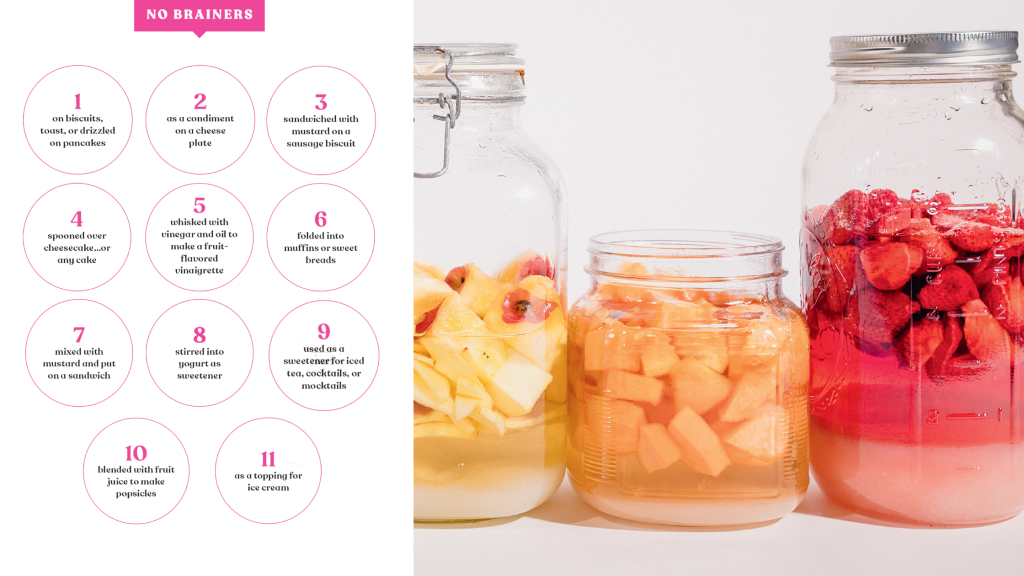Sweet Potential
From This Will Make It Taste Good by Vivian Howard
SWEET POTENTIAL

HERE’S WHAT’S IMPORTANT
I’ve provided a recipe for a large-ish quantity of Sweet Potential because the work of this is not multiplied by the batch size. Four pounds of fruit requires basically the same amount of work as 2 pounds of fruit, and if I’m going to the trouble to do something like this I generally like to make it count. But you can cut this recipe in half or even thirds with great success.
Sweet Potential will keep in a sealed container in your fridge for 3 months. Contrary to conventional wisdom, because of its high sugar content, it will keep on your counter just fine for at least a week. Or you may can it in a hot water bath and keep it in the pantry forever.
This is a super-simple, three-step process, but there are some nuances related to the type of fruit you choose and what you plan to do with it. Here is what I know on the subject…which is a lot.
- Sweet Potential’s recipe calls for a weight of fruit. Always weigh the fruit after you’ve trimmed, peeled, or cut fruit away from its core.
- Apples and pears are among my favorite fruits to preserve. Their flavor is one we already expect in savory food, so the Sweet Potential from these tree fruits is an apt match in lots of recipes. Choose a crisp eating apple like Fuji, Gala, or Pink Lady rather than a tart green apple like Granny Smith. (I don’t like Red or Yellow Delicious apples…for anything.) Same goes for pears—the crisper, the better. If you treat them correctly, slivers of apple and pear not only hold their shape, they also maintain a snappy texture that startles palates expecting more applesauce than apple chip. Always, always, always peel the apples and pears you plan to preserve or the skins will toughen and ruin your efforts. Cut them away from their cores and slice them into slivers or small cubes before they macerate. Then I toss the cores in anyway because I like the way they look in the final product.
- Berries of all kinds can be preserved whole and don’t need to be crushed prior to maceration, but make sure you cut off the caps of strawberries and choose plump, firm blackberries and raspberries. Soft fruit past its prime will cloud the syrup.
- Figs are an ideal choice for Sweet Potential because they can be preserved whole and therefore provide dramatic presentation. Leave a little of the stem intact. It will help hold the fruit together. And only choose the firm ones, as soft, past-their-prime figs really want to be jam.
- Like apples, peaches, cherries, nectarines, and apricots are flavors we’re used to seeing in savory foods, so they all make great choices for Sweet Potential. Because of their fuzzy skins, peaches, nectarines, and apricots need to be peeled. To do this, cut a superficial X in the bottom of each fruit and drop them in boiling water for roughly 20 seconds. Then transfer them to an ice bath. Once cool, peel the skins away and cut them into wedges. Other stone fruits like cherries have less aggressive skins and need only to be pitted before they macerate.
- Muscadine and concord grapes, or any grapes with seeds and thick skins, are entirely different beasts and more work, but their foxy flavor is worth the trouble. Begin by cooking whole grapes in a Dutch oven or saucepan with just a little water. The skins will pop and open up. Continue cooking until you see the pulp soften and separate from the seeds. Pass the grapes through a sieve. On top you’ll have the hulls and the seeds. Underneath you will have pulp. Discard the seeds and put the hulls back in the pan with just enough water to cover. Bring that to a boil, uncovered, and cook until most of the water has evaporated. Combine the hulls and pulp and weigh the mixture. Then add an equal weight of sugar and macerate overnight.
- Watermelon is a Sweet Potential gold mine. To preserve its flesh, remove the seeds, cut into cubes, weigh, and macerate with the same weight of sugar, just as you would other fruits. The flesh from melons like cantaloupe and honeydew works in this way as well. To preserve the watermelon rind, peel off the outer green layer and cut the rind into small strips or cubes. Then macerate.
- Citrus, like lemons, limes, and oranges, is a bit tricky. The flesh itself, when cut into supremes without the rind, tends to break down into a bright but pleasant mess once it meets heat. That wouldn’t matter so much, but cutting citrus into supremes or slices void of any rind is a lot of work just to have it cook into jam. The more common thing to do is to preserve whole slices of citrus with the rind intact. This approach is suitable for some recipes but the bitterness from the rind diminishes its range quite a bit. To get around this, I like to combine oranges, lemons, and limes with other fruits to preserve, but even here, try to choose citrus with a thinner pith.
- Many times cooks will add spices like cloves, coriander, or cinnamon to their fruit preserves to make them more interesting. If you choose to do this, incorporate spices from the beginning as they macerate, then include them as they cook. I’ve chosen not to embellish Sweet Potential with anything other than lemon slices because the strong flavors from spice make preserves less versatile in recipes. Instead incorporate spices, herbs, and additional flavors for specific recipes as you go.
MAKES 6 QUARTS
INGREDIENTS
| 4 pounds fresh fruit Up to 4 pounds granulated sugar 1 lemon or lime, sliced thin |
1. Once you’ve peeled, sliced, diced, and weighed the fruit (see above), toss it with an equal weight of sugar, plus the lemon or lime slices, in a Dutch oven. Cover and let macerate overnight. I keep this on the counter because I don’t have room in the fridge for something that big and the fruit doesn’t mind room temperature for a spell.
2. The next day you’ll see a syrup has formed around the fruit. There may still be pockets of sugar that have not fully dissolved and that’s totally fine. Transfer the Dutch oven to the stove and bring it up to a simmer over medium heat. I always stir it a bit in the beginning to prevent any sugar from burning, but I’ve never come close to ruining this and I ruin a lot of stuff, so don’t fret.
3. Once it’s at a strong simmer, cover, lower the heat slightly, and cook for 15 minutes, or up to 1 hour.
4. For fruits like strawberries, blackberries, figs, and watermelon flesh, 15 minutes may be all the time you need. For these you want the fruit to shrink a bit and the syrup to take on the pale color of the fruit suspended in it. The preserves don’t get better the longer you cook them, so don’t be a hero and simmer until the syrup thickens. If you do, your preserves will be sticky and unmanageable once they cool. Let the preserves sit at room temperature at least an hour before you refrigerate them. The cooling process is important as it allows fruits like strawberries and watermelon the chance to plump up with syrup and appear less shriveled.
5. For apples, pears, citrus, and watermelon rinds, you’ll need to cook them a bit longer until some of the fruit becomes translucent. This can take up to an hour, so you’ll need to keep an eye on the syrup to make sure it doesn’t begin to darken into caramel. Just as with the other fruits, you want this syrup to be pale and thin, so adjust it with water as needed. If it seems as if the syrup begins to reduce in volume, add a cup or so of water to ward off thick, difficult-to-work with preserves. Once about a third of the preserves have taken on that clear veneer, turn the heat off and let them cool in the syrup. As they cool, most of the remaining fruit should also wane translucent.
6. Transfer the fruit and syrup into jars, and there you have it. Preserved fruit floating in syrup equals Sweet Potential that will keep in your fridge for basically forever. But this is a book and I can’t really claim that, so make the most of your Sweet Potential within 3 months.
Excerpted from THIS WILL MAKE IT TASTE GOOD by Vivian Howard. Copyright © 2020 from Voracious Books, an imprint of Hachette Book Group.
From caramelized onions to fruit preserves, make home cooking quick and easy with ten simple "kitchen heroes" in these 125 recipes from the New York Times bestselling and award-winning author of Deep Run Roots.
“I wrote this book to inspire you, and I promise it will change the way you cook, the way you think about what’s in your fridge, the way you see yourself in an apron.”
Vivian Howard’s first cookbook chronicling the food of Eastern North Carolina, Deep Run Roots, was named one of the best of the year by 18 national publications, including the New York Times, USA Today, Bon Appetit, and Eater, and won an unprecedented four IACP awards, including Cookbook of the Year. Now, Vivian returns with an essential work of home-cooking genius that makes simple food exciting and accessible, no matter your skill level in the kitchen.
Each chapter of This Will Make It Taste Good is built on a flavor hero—a simple but powerful recipe like her briny green sauce, spiced nuts, fruit preserves, deeply caramelized onions, and spicy pickled tomatoes. Like a belt that lends you a waist when you’re feeling baggy, these flavor heroes brighten, deepen, and define your food.
Many of these recipes are kitchen crutches, dead-easy, super-quick meals to lean on when you’re limping toward dinner. There are also kitchen projects, adventures to bring some more joy into your life. Vivian’s mission is not to protect you from time in your kitchen, but to help you make the most of the time you’ve got.
Nothing is complicated, and more than half the dishes are vegetarian, gluten-free, or both. These recipes use ingredients that are easy to find, keep around, and cook with—lots of chicken, prepared in a bevy of ways to keep it interesting, and common vegetables like broccoli, kale, squash, and sweet potatoes that look good no matter where you shop.
And because food is the language Vivian uses to talk about her life, that’s what these recipes do, next to stories that offer a glimpse at the people, challenges, and lessons learned that stock the pantry of her life.
